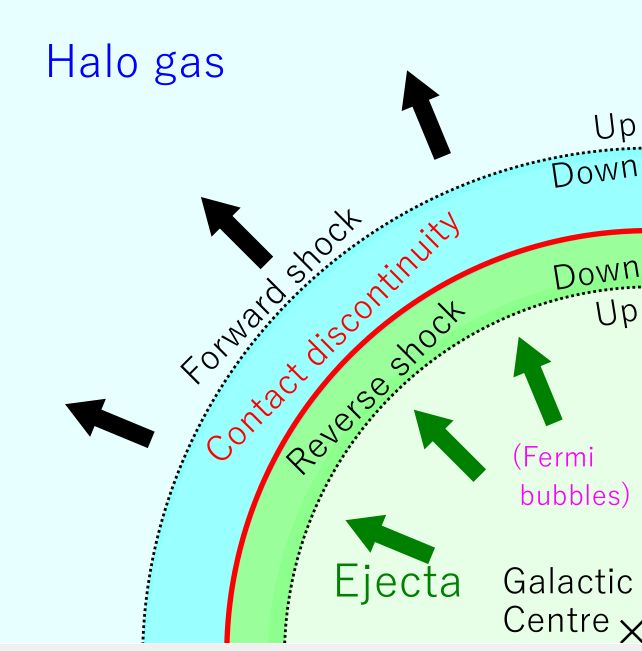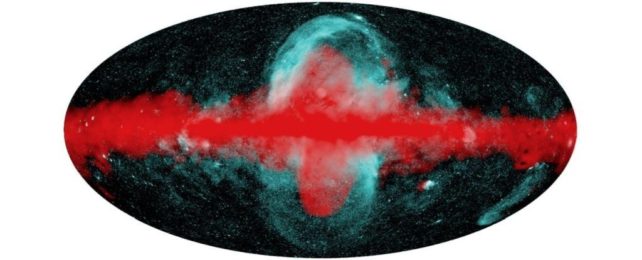When the Fermi Gamma-Ray Space Telescope entered low-Earth orbit in 2008, it opened our eyes to a whole new Universe of high-energy radiation.
One of its more curious discoveries was the Fermi Bubbles: giant, symmetrical blobs extending above and below the galactic plane, 25,000 light-years on each side from the Milky Way's center, glowing in gamma-ray light – the highest energy wavelength ranges on the electromagnetic spectrum.
Then, in 2020, an X-ray telescope named eROSITA found another surprise: even bigger bubbles extending over 45,000 light-years on each side of the galactic plane, this time emitting less energetic X-rays.
Scientists have since concluded that both sets of bubbles are probably the result of some sort of outburst or outbursts from the galactic center and the supermassive black hole therein. The mechanism producing the gamma- and X-radiation, however, has been a little harder to pin down.
Now, using simulations, physicist Yutaka Fujita from Tokyo Metropolitan University in Japan has come up with a single explanation that explains both sets of bubbles in one fell swoop.
The X-ray emission, he has found, is the product of a powerful, fast-moving wind that slams into the tenuous gas filling interstellar space, producing a shock wave that reverberates back through the plasma, causing it that energetic glow.
The supermassive black hole that powers the heart of the Milky Way – Sagittarius A* – is pretty quiet as far as black holes go. Its feeding activity is minimal; it's classified as "quiescent". It hasn't always been that way, though. And an active black hole can have all sorts of effects on the space around it.
As material falls towards the black hole, it heats up and blazes with light. Some of the material gets channeled away along magnetic field lines outside the black hole, which act as a synchrotron to accelerate particles to near-light speed. These are launched as powerful jets of ionized plasma from the black hole's poles, punching out into space for up to millions of light-years.
In addition, there are cosmic winds: streams of charged particles that are whipped up by the material orbiting the black hole that then blast out into space.
While Sagittarius A* may be quiet now, that hasn't necessarily always been the case. Look hard enough, and relics of past activity, such as the Fermi bubbles, can be found lurking in the space around the galactic plane. By studying these relics we can understand when and how that activity took place.
Fujita's foray into the Fermi bubbles is based on data from the now-retired Suzaku X-ray satellite, jointly operated by NASA and the Japanese Space Agency (JAXA). He took Suzaku observations of the X-ray structures associated with the bubbles and performed numerical simulations to try to reproduce them based on black hole feeding processes.

"We show that a combination of the density, temperature, and shock age profiles of the X-ray gas can be used to distinguish the energy-injection mechanisms," he writes in his paper.
"By comparing the results of numerical simulations with observations, we indicate that the bubbles were created by a fast wind from the galactic center because it generates a strong reverse shock and reproduces the observed temperature peak there."
The most likely scenario, he found, is a black hole wind blowing at a speed of 1,000 kilometers per second (621 miles) from a past feeding event that was metered out over the course of 10 million years and ended fairly recently. As the wind propagates outwards, the charged particles collide with the interstellar medium, producing a shock wave that bounces back into the bubble. These reverse shock waves heat the material inside the bubbles, causing it to glow.
The numerical simulations developed by Fujita accurately reproduced the temperature profile of the X-ray structure.
He also investigated the possibility of a single explosive eruption from the galactic center and was unable to reproduce the Fermi bubbles. This suggests that a slow, steady wind from the galactic center was the most likely progenitor of the mysterious structures. And the power of the wind can only be attributed to Sagittarius A*, not star formation – another phenomenon that produces cosmic winds.
"Thus," he writes in his paper, "the wind may be the same as active galactic nuclei outflows often observed in other galaxies and thought to regulate the growth of galaxies and their central black holes."
The paper has been published in the Monthly Notices of the Royal Astronomical Society.
